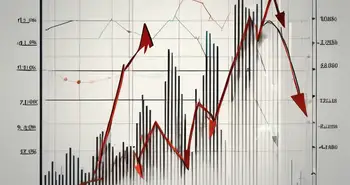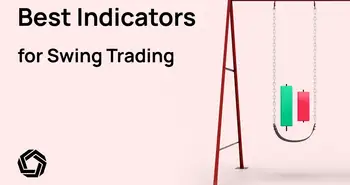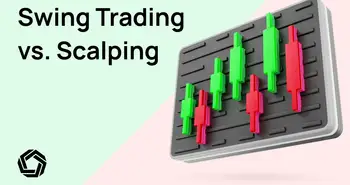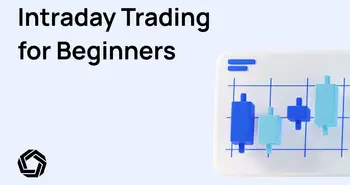Swing Trading Strategies for Beginners
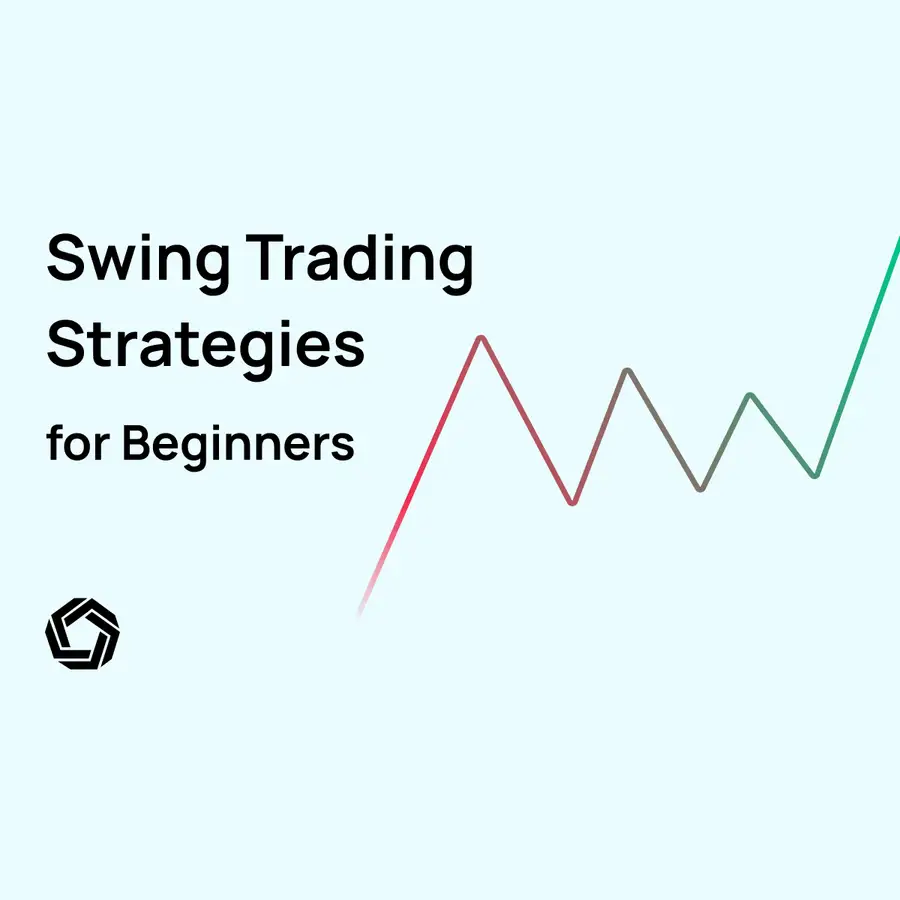
Swing trading is a trading style where traders aim to capture gains from an asset’s price movements over a period of a few days to several weeks. Successful swing traders use technical indicators to identify potential buy-low and sell-high signals.
It is a strategy that is used in a trader's arsenal alongside other tools of the trade. But when used correctly, it can be a thing of beauty – a dance between the trader and the market that can yield incredible profits.
Swing trading is a hybrid strategy, not as short-term as intraday trading but shorter than long-term investments. Yet, swing traders typically earn higher profit margins by executing fewer transactions than their intraday counterparts. For example, a swing trader's goal is to cash in on a stock price increase of $10, which may take several trading days. In contrast, intraday traders seek profits from a 20-cent increase in just a couple of hours.
To make informed trade decisions, swing traders rely on fundamental and technical analyses. Technical analysis studies past price movements to identify potential future price movements. Swing traders scrutinize trends, momentum, volatility, and volume indicators, reviewing four-hour charts (4H) and daily charts (D1).
On the other hand, fundamental analysis evaluates a stock's underlying business fundamentals and financial metrics instead of historical pricing data. Swing traders rely on metrics such as earnings per share (EPS), the price-to-earnings ratio (P/E), the price-to-book ratio (P/B), and return on equity (ROE) to perform fundamental analysis.
There is a vast toolbox of indicators for swing trading to choose from. These include utilizing support and resistance levels, analyzing moving averages (like Exponential Moving Averages), and employing Fibonacci retracement patterns.
Benefits of Swing Trading:
- Can generate higher profit margins compared to intraday trading
- Doesn't require constant monitoring of the markets like intraday trading
- Provides opportunities to capitalize on pricing swings within market cycles
- Combines technical and fundamental analyses to make informed trade decisions
- Offers flexibility to adjust strategies based on changing market conditions
One thing to remember is that swing trading can be a lucrative trading strategy, but it requires a disciplined approach to be successful. Having a strategy in place is crucial to help minimize risks and increase the chances of success. It enables traders to establish clear entry and exit points, set profit targets and stop losses, and identify which indicators to use for technical and fundamental analysis. Without a strategy, traders may make emotional and impulsive decisions that can lead to losses due to a wrong mindset. A well-thought-out strategy helps traders to stay focused, disciplined, and objective in their decision-making, increasing their chances of success in the markets.
Understanding the Market
The market is known for its ups and downs, making it a challenging environment for investors and traders alike. Swing traders, who aim to profit from pricing swings within market cycles, also face these challenges. While strong market cycles and trends can provide good opportunities for swing traders to capitalize on, volatile market conditions can make it trickier to identify clear trends and trading opportunities.
For example, factors such as news and events can impact market sentiment and cause sudden shifts in stock prices, making it difficult for swing traders to make informed decisions. Then the motto changes from preparing your strategy and going by the saying “Take your time to do it right” to throwing the plan out the window and adapting to “Strike while the iron is hot.
Moreover, macroeconomic factors such as interest rates and policy decisions made by central banks or governments can also impact swing trading strategies. Changes in interest rates can cause shifts in market momentum, creating opportunities for swing traders to ride the wave. Similarly, policy decisions like quantitative easing can lead to increased market liquidity and potentially create more opportunities for swing traders.
So as always, it is crucial to understand the market:
“You get recessions, you have stock market declines. If you don't understand that's going to happen, then you're not ready, you won't do well in the markets.” – Peter Lynch
Swing Trading Strategy Ideas
Breakout Trading
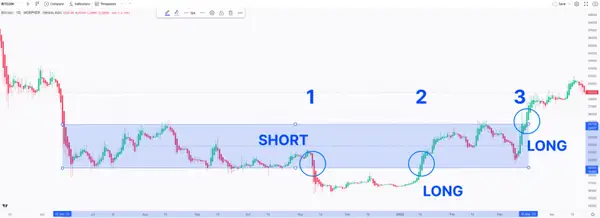
The first trading strategy idea is about breakout trading and how to spot short and long-term channels to find breakout opportunities. Breakout trading is a trading strategy that involves entering a position when the price of an asset breaks through a key level of support or resistance. The idea is that the price will continue to move in the same direction as the breakout, leading to potential profits.
Trendlines are used in breakout trading to identify these key levels of support and resistance. A trendline is a straight line that is drawn between two or more price points on a chart, and it is used to identify the direction of the trend. In a breakout trading strategy, traders will typically look for a break above a trendline as a signal to enter a long position or a break below a trendline as a signal to enter a short position.
In this case, we are showing this trading strategy on the Bitcoin chart. Here the upper line in the channel is the resistance level, and the bottom line is the support line. The resistance level is around 24700, and the support is around 19000. In this case, we could have taken three trades, once when the support line was broken, which would have given you a nice swing trade from 1900 to 16000. The second trade would have been when the new resistance level was broken the first time, taking you from 19000 to around 22000. After, the third trade can be taken once the higher resistance level is broken, taking you from 24700 to over 30000. In all cases, the swing trade was very visible, so you could have made a significant profit with leverage.
Trend following with Heikin Ashi
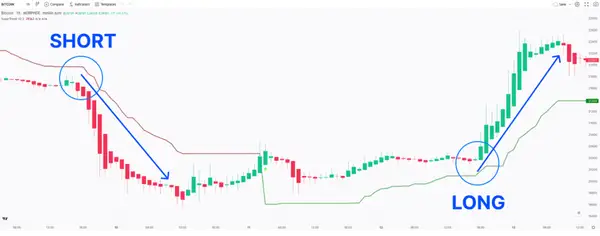
If you want to trade shorter time periods, you may rely on a combination of Heikin Ashi Candles in combination with the SuperTrend Indicator. We have also been using them in various of our previous strategies, as they are great for following trends.
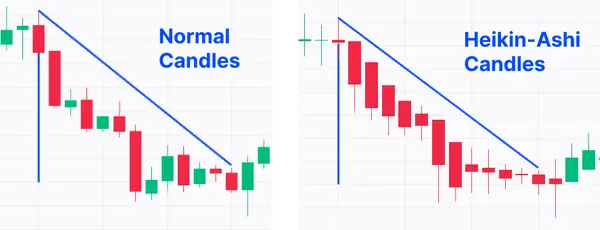
To identify a strong downtrend, look for a consolidation period with smaller real body or doji candles. The first sign of a downward trend is typically a larger real-body candle with no upper shadow. As the trend continues, the candles become larger with no upper shadows and increasing lower shadows, indicating that there is little pressure upwards and increasing pressure downwards. The SuperTrend indicator can be used as a reference, showing brown/red during the downtrend. In this particular case, a strong downward trend began around 21700 and ended around 19900, resulting in a profit of almost 10% on a short Bitcoin position, which can be even more profitable with leverage. When the candles start to decrease in size with upper shadows appearing, it’s time to re-evaluate your position and consider exiting the trade.
After a consolidation at the bottom, the market trends sideways, preparing for another move. As the trend gains momentum, the candles become larger, with almost no shadows at the bottom. When the candles start to decrease in size, it indicates that the upward trend may be coming to an end, and it’s time to re-evaluate your position. Changing candle colors indicate the end of a strong upward trend for that period, signaling that it’s time to exit the position. With this strategy, the trend moved from 20400 to 22400, resulting in a profit of almost 10% or more with leverage.
By recognizing the characteristics of an uptrend and downtrend, we can make informed trading decisions and increase our chances of achieving profitable returns. Keep in mind that trends can change quickly, so it’s important to monitor the market closely and adjust your strategy accordingly.
Counter-trend trading
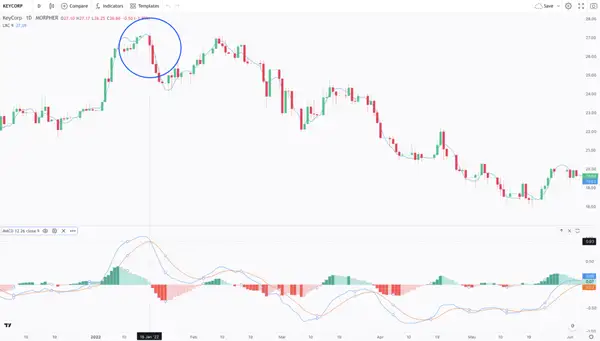
For this strategy, we use two indicators – MACD and LRC – to identify potential trend reversals. Both indicators work well together as they can be used to detect changes in momentum. It is a universal strategy, which we tried on the KeyCorp (KEY) chart, a retail bank. Following a significant hike in 2021, KeyCorp’s market experienced a downtrend reversal.
The Moving Average Convergence Divergence (MACD) shows the relationship between two moving averages, in our case, the 12-day and 26-day MA. The most important signal it provides is a crossover of the MACD line and the signal line, indicating a change in momentum and potential buy or sell signals.
The LRC (Linear Regression Channel) is a technical analysis indicator that is used to identify trends and potential trend reversals in the market. The LRC uses linear regression to draw a channel around the price action of an asset. The upper and lower boundaries of the channel represent the upper and lower limits of the asset's trend.
To start, we look for an established trend in the market. Once we have identified the trend, in this case, it is an uptrend, we keep an eye out for a potential reversal. The first indicator we check is the MACD. If the value on the MACD is nearing a peak and shows signs of decreasing, it could be an indication that the current trend is losing momentum, and a reversal may be imminent.
The second indicator we use is the LRC. We check for a change in the LRC line, which could suggest that the market is no longer trending in its previous direction. Once we have observed both of these indicators, we wait for a confirmation of a trend reversal. This confirmation could be in the form of a decrease in the value on the MACD or a crossing of the LRC line.
Once we have confirmed a trend reversal, we can open a counter-trend position. To manage risk, we set a stop-loss above the most recent high or resistance level, in this case around the 27 value. So, as you can see, using these indicators and waiting for a confirmation of a trend reversal, we can make informed trading decisions and increase our chances of achieving profitable returns. Especially in this case, you could have made a significant profit taking your trade at the 27 level all the way down to the 20 level.
Tips for Successful Swing Trading
Unfortunately, having great strategies and the theory planned out is not everything in trading. First and foremost, you also need to stick to your plan, no matter what the market throws at you. Don't deviate from it just because you're feeling greedy or scared. Stick to your plan like a pitbull on a bone, and you'll come out on top.
But sticking to a plan isn't enough. You need to manage your emotions too. Fear, greed, and impatience are the enemies of every trader out there. They'll make you sell too early or buy too late. They'll cloud your judgment and make you second-guess your decisions. So learn to control your emotions and stick to your plan.
And lastly, never stop learning and improving. The market is constantly changing, and you need to adapt to stay ahead of the game. Read the best books on technical analysis, and books on forex and candlestick patterns, follow the most successful swing traders, and keep up-to-date with the latest news and trends. The more you learn, the better you'll become.
Conclusion
So, there you have it, a full guide to start you on your swing trading journey. Swing trading requires a solid strategy, knowledge of market conditions, risk management, and continuous improvement. If you're willing to put in the effort, swing trading can be a lucrative endeavor. In the end, it might be possible to crack the code and find some great swing trading possibilities.

Disclaimer: All investments involve risk, and the past performance of a security, industry, sector, market, financial product, trading strategy, or individual’s trading does not guarantee future results or returns. Investors are fully responsible for any investment decisions they make. Such decisions should be based solely on an evaluation of their financial circumstances, investment objectives, risk tolerance, and liquidity needs. This post does not constitute investment advice.

Painless trading for everyone
Hundreds of markets all in one place - Apple, Bitcoin, Gold, Watches, NFTs, Sneakers and so much more.

Painless trading for everyone
Hundreds of markets all in one place - Apple, Bitcoin, Gold, Watches, NFTs, Sneakers and so much more.

